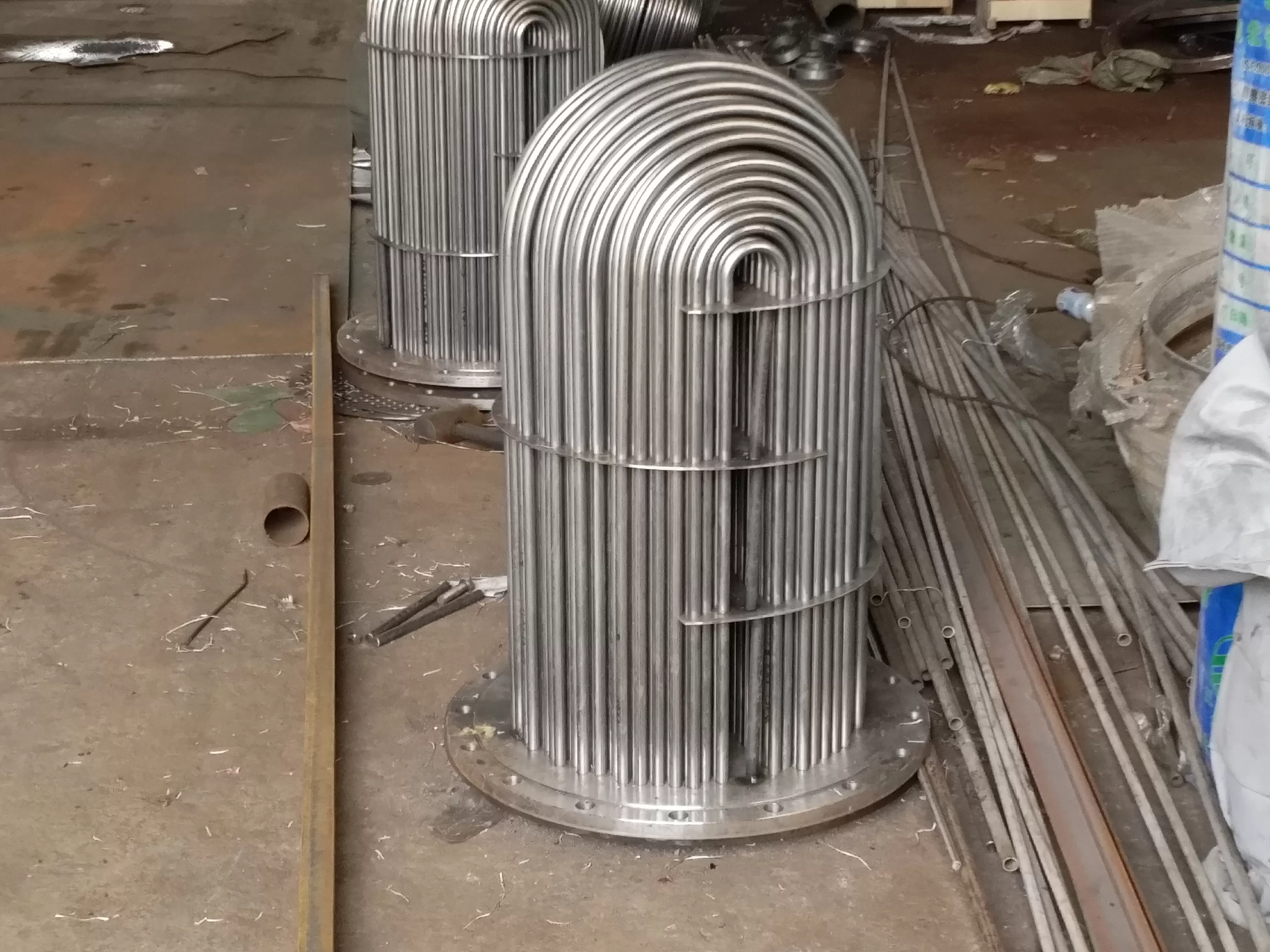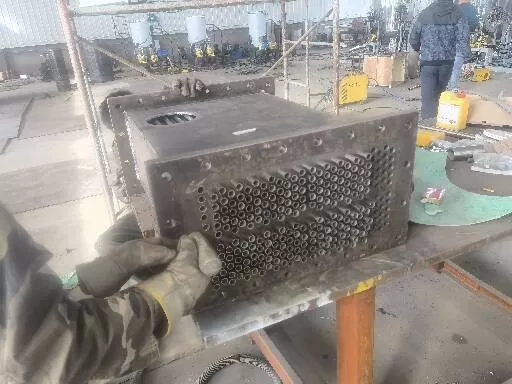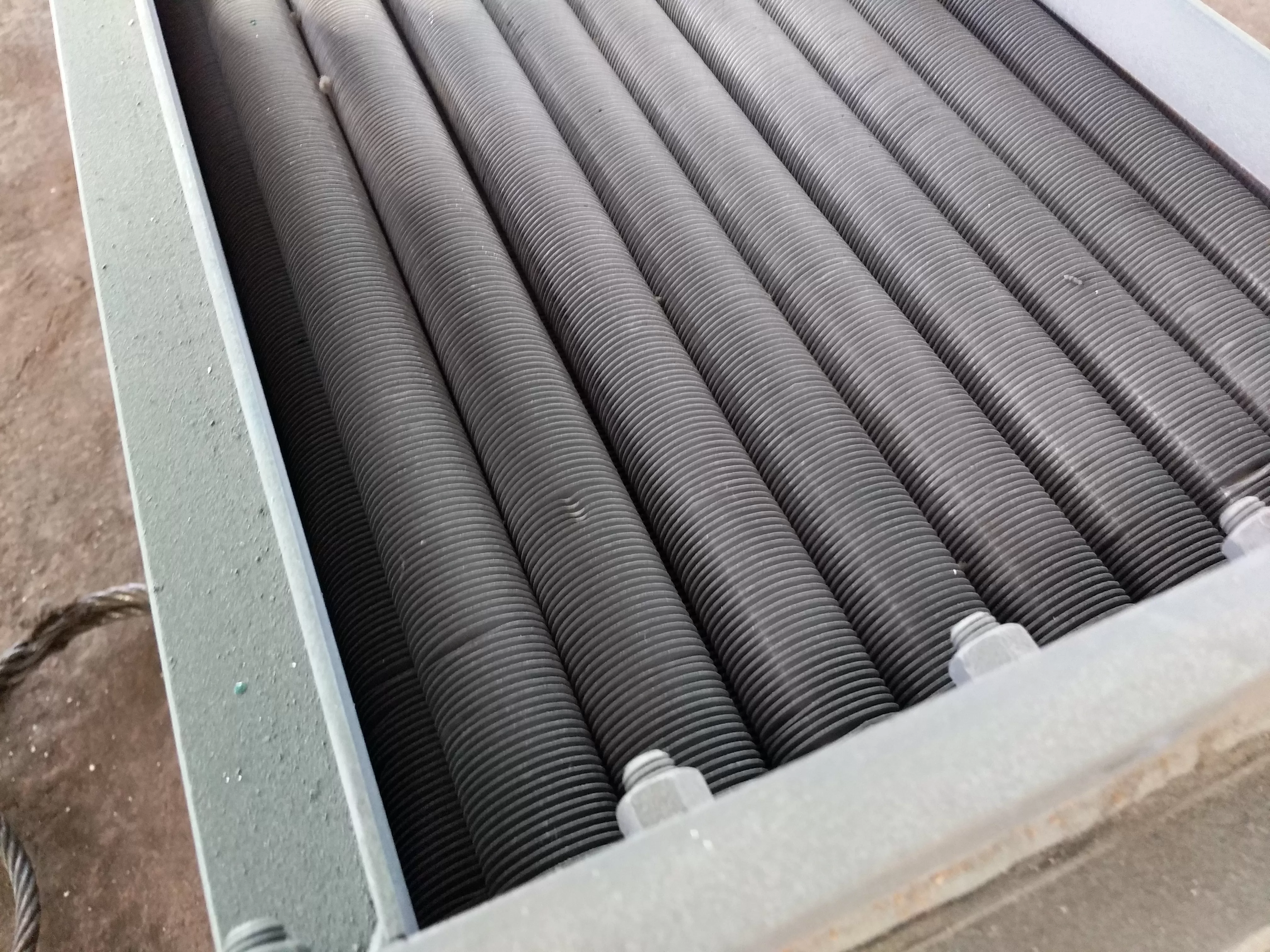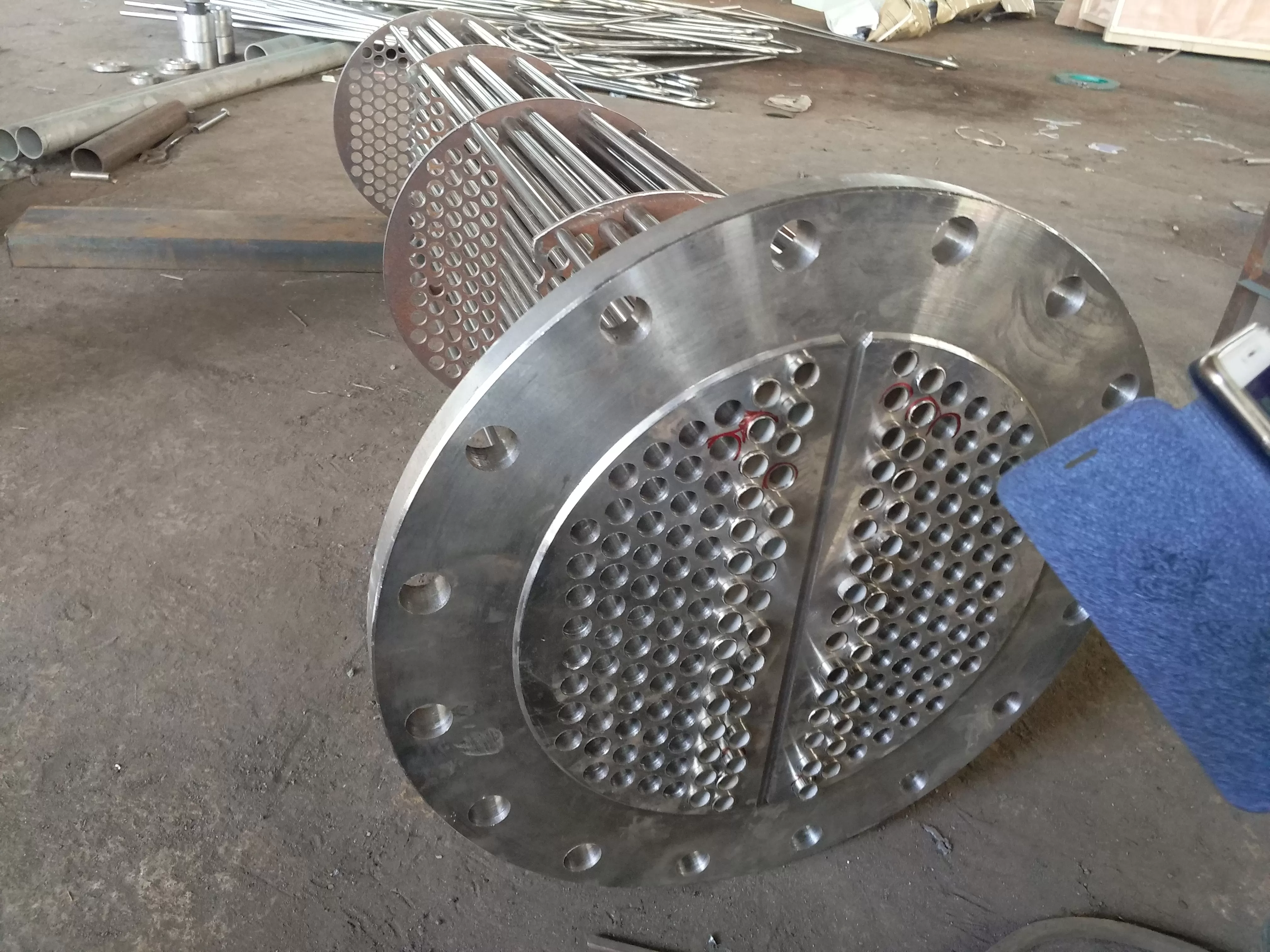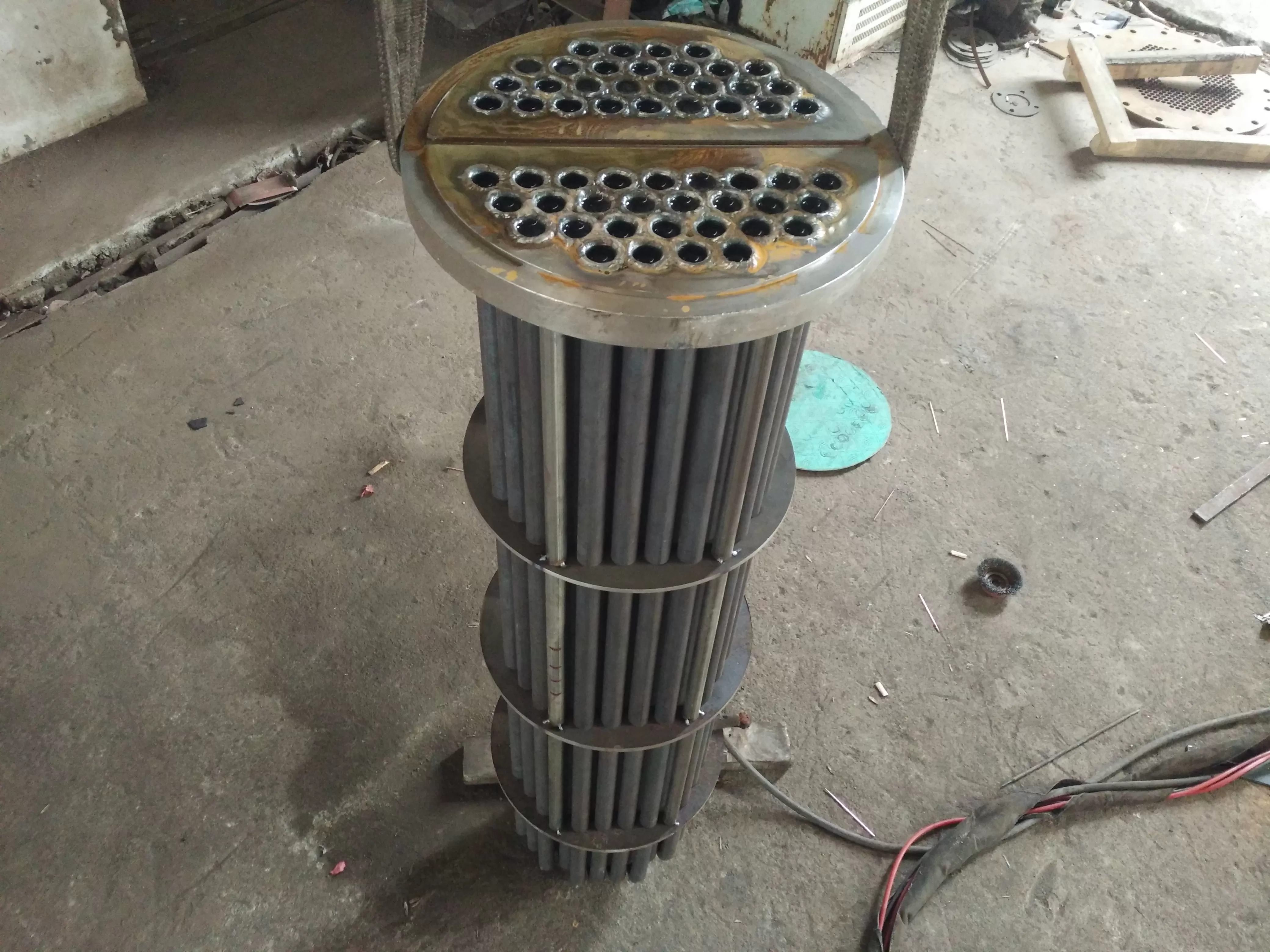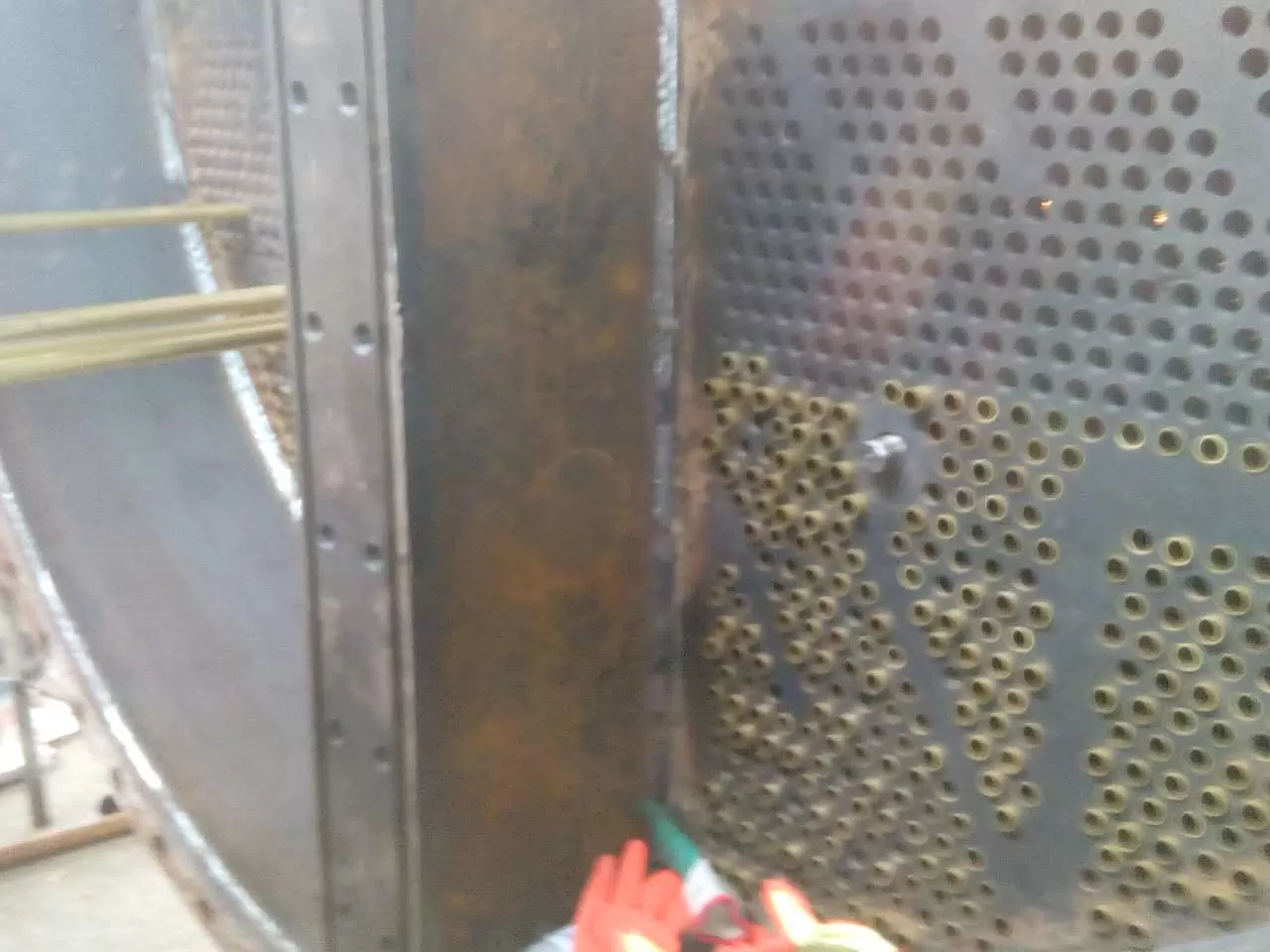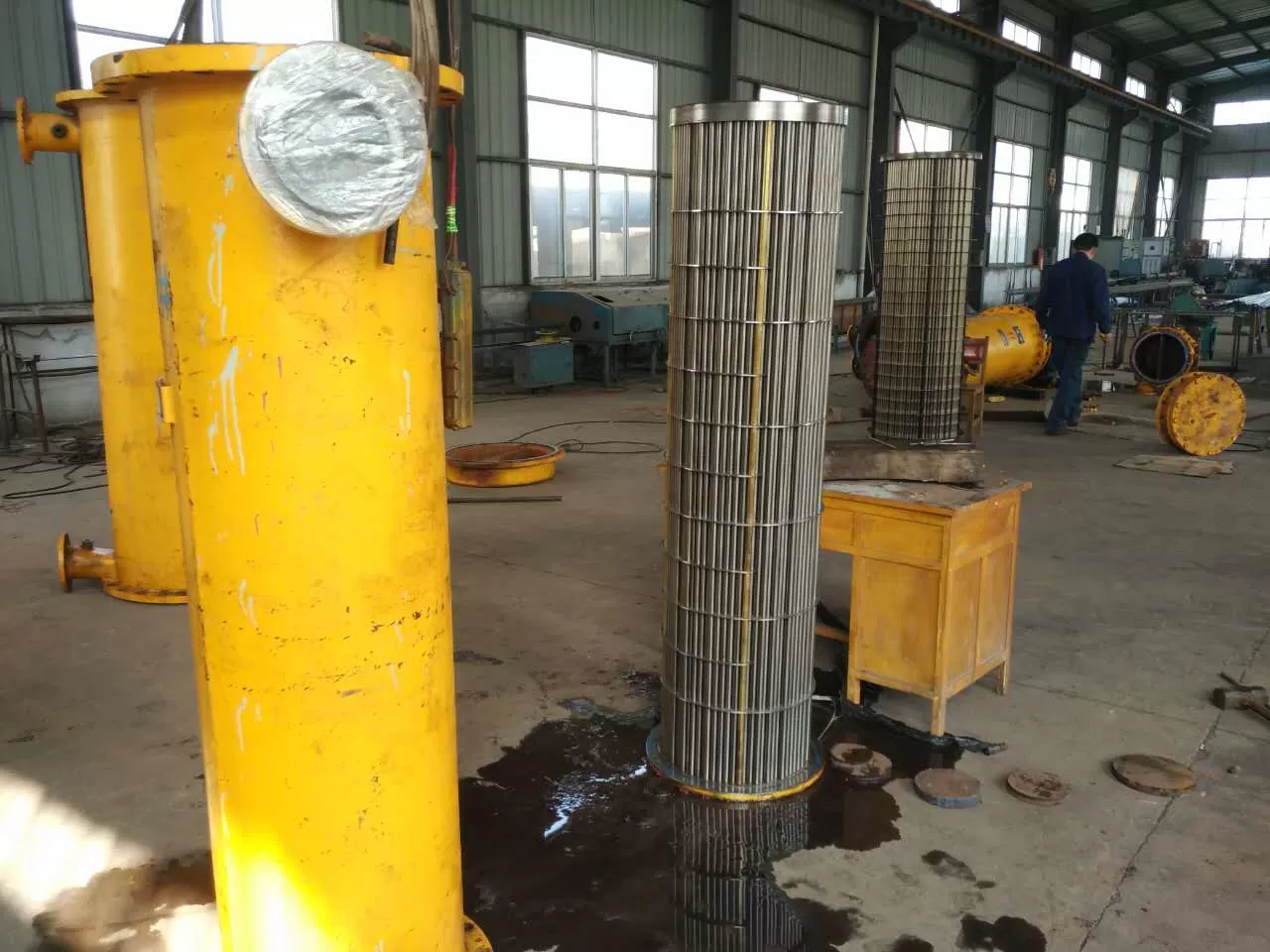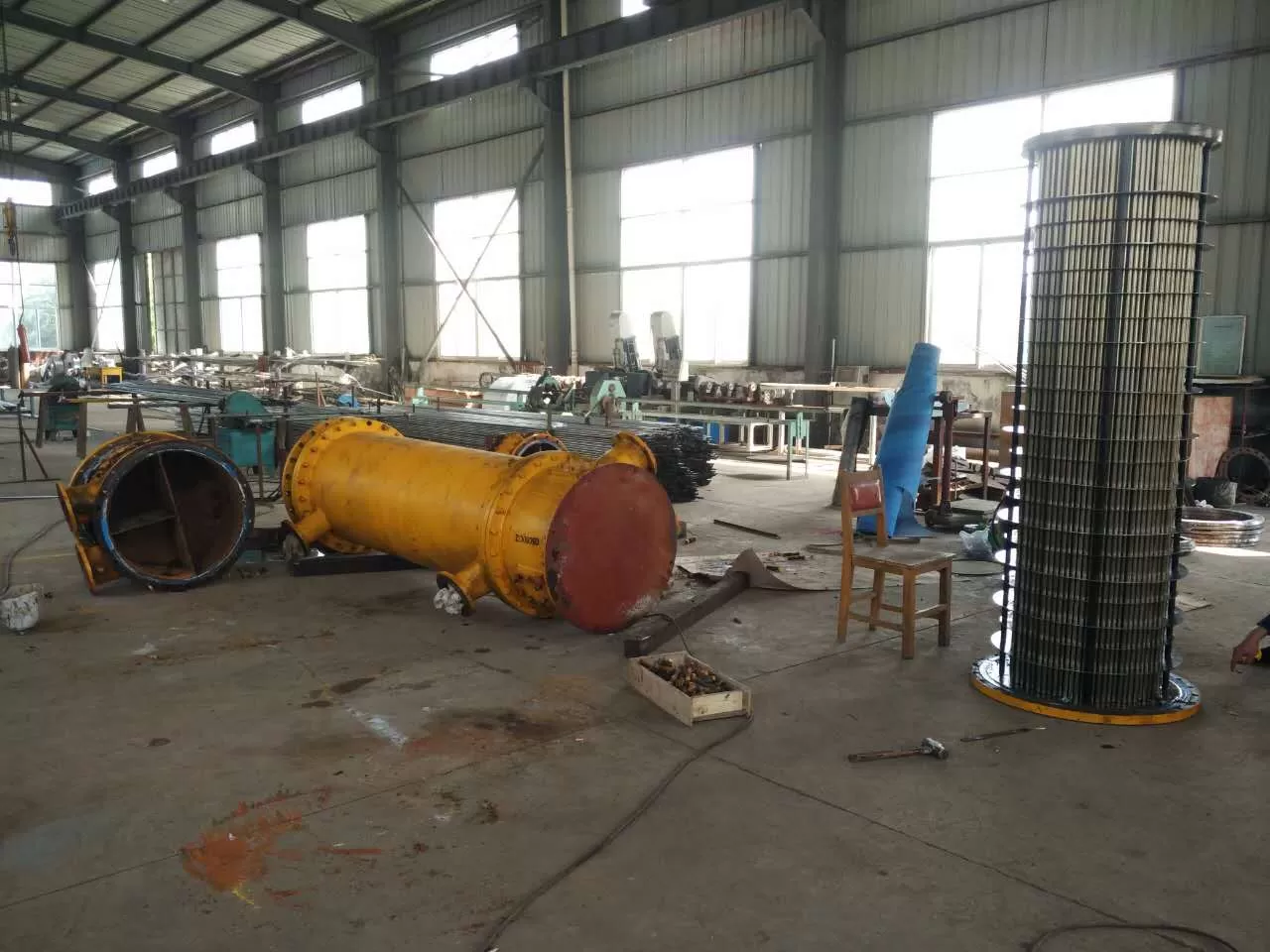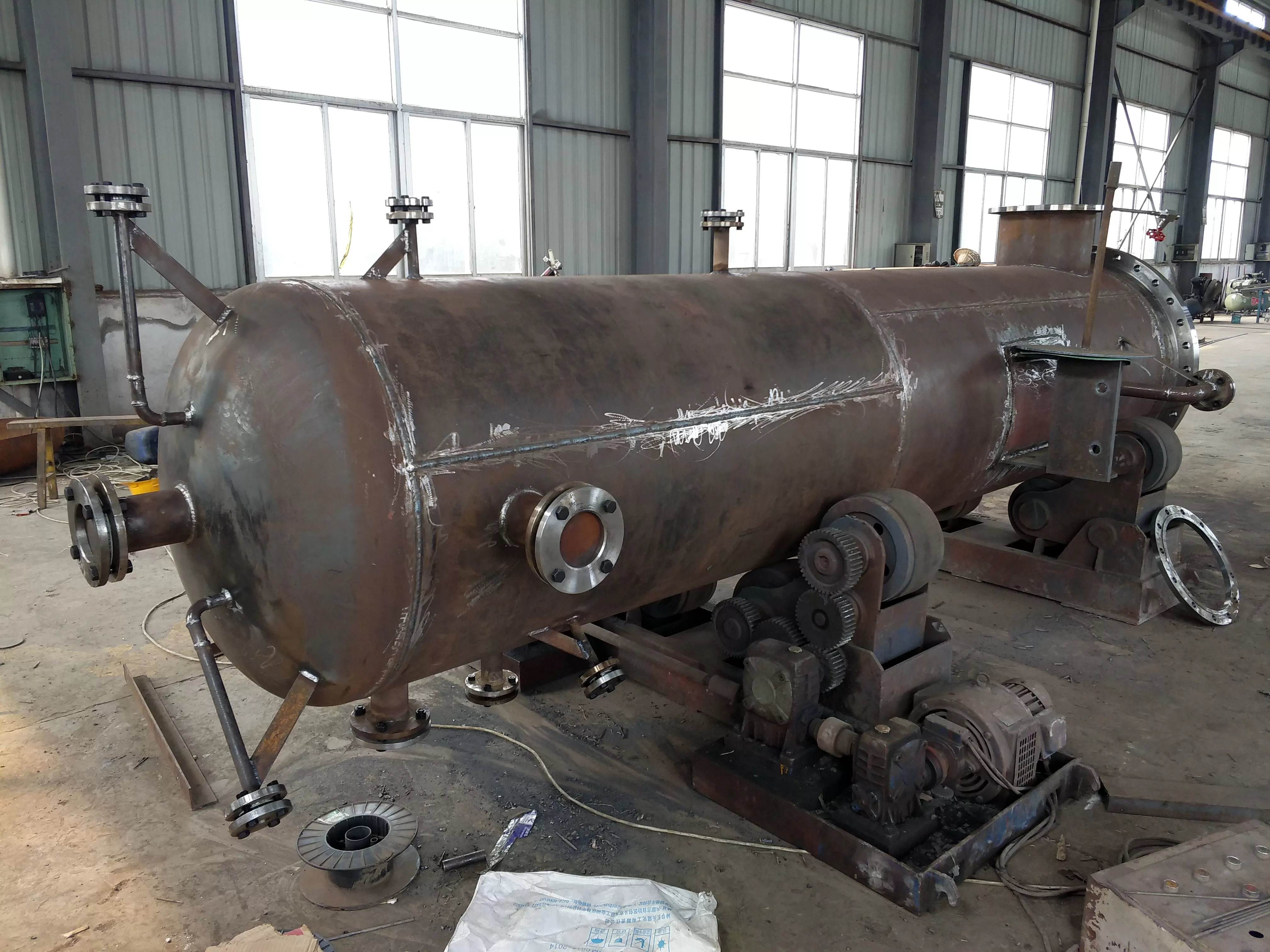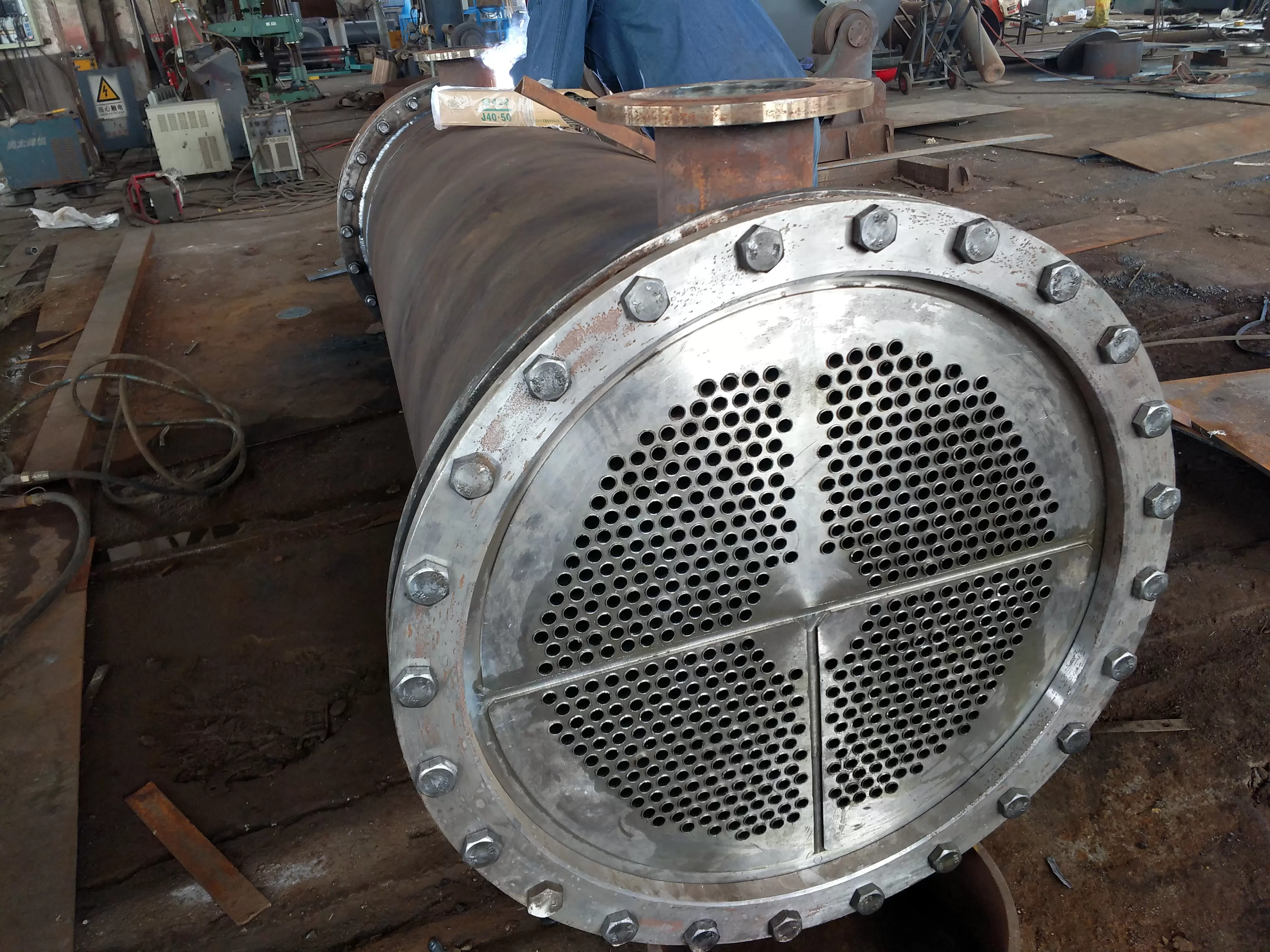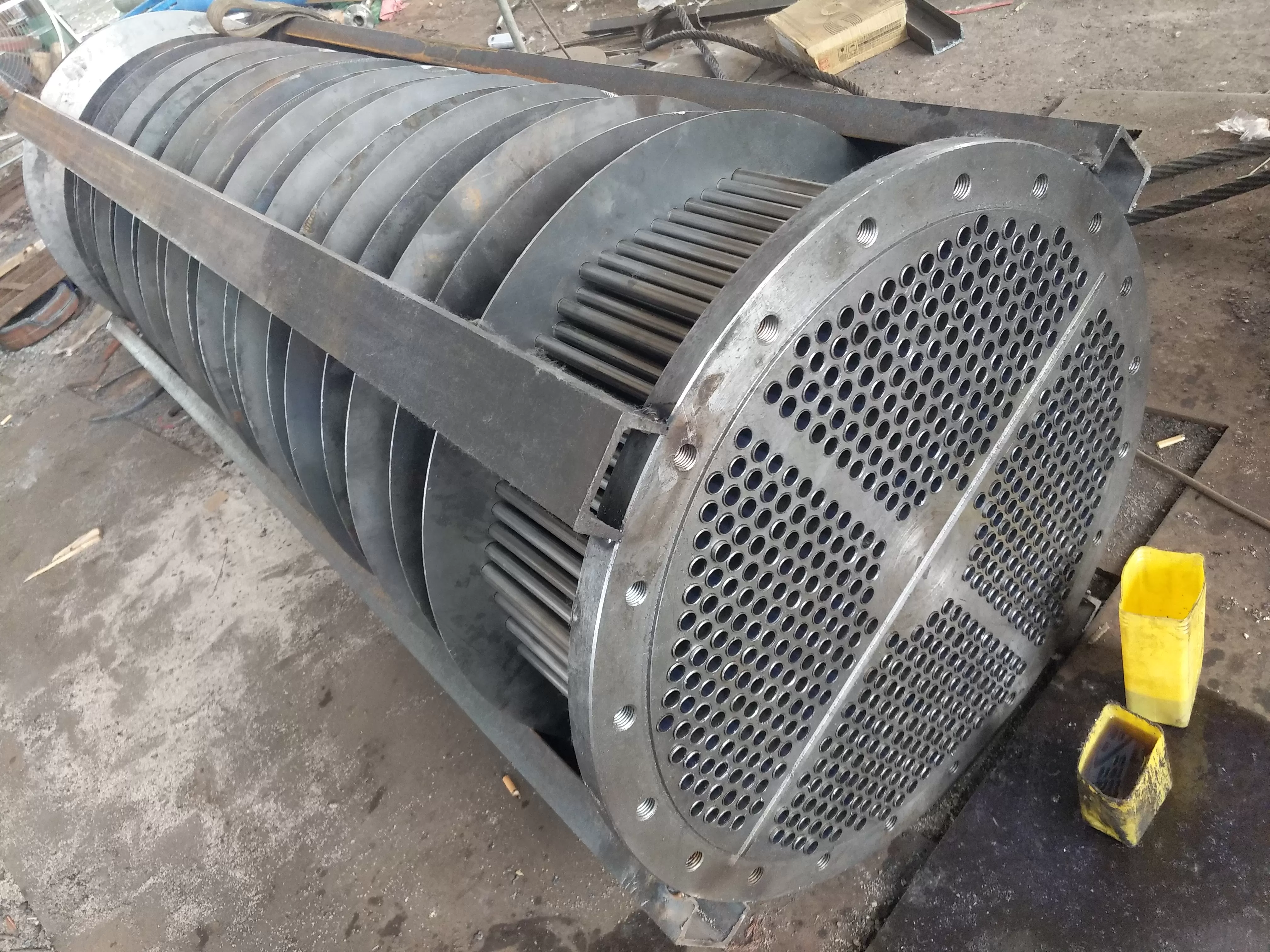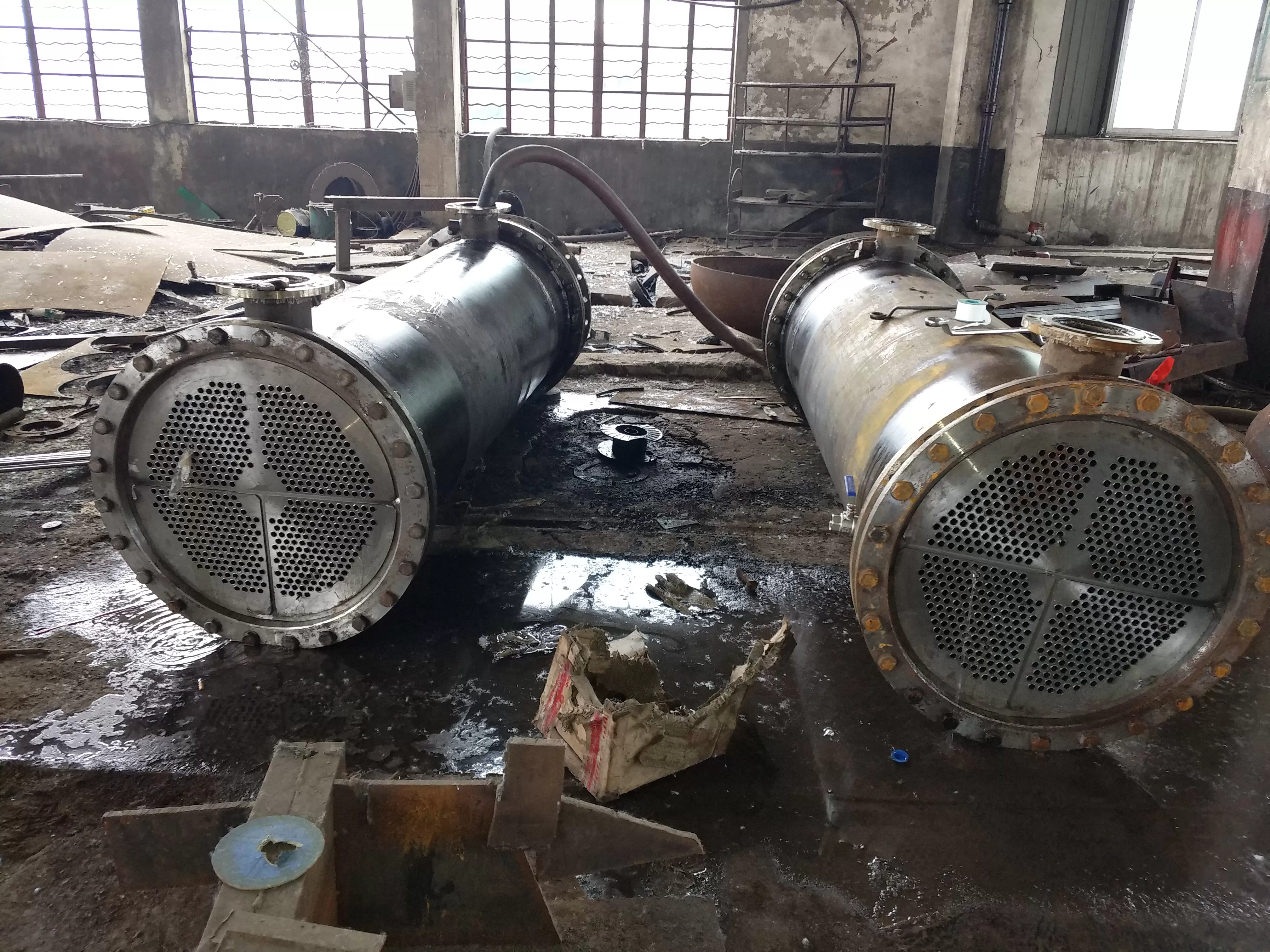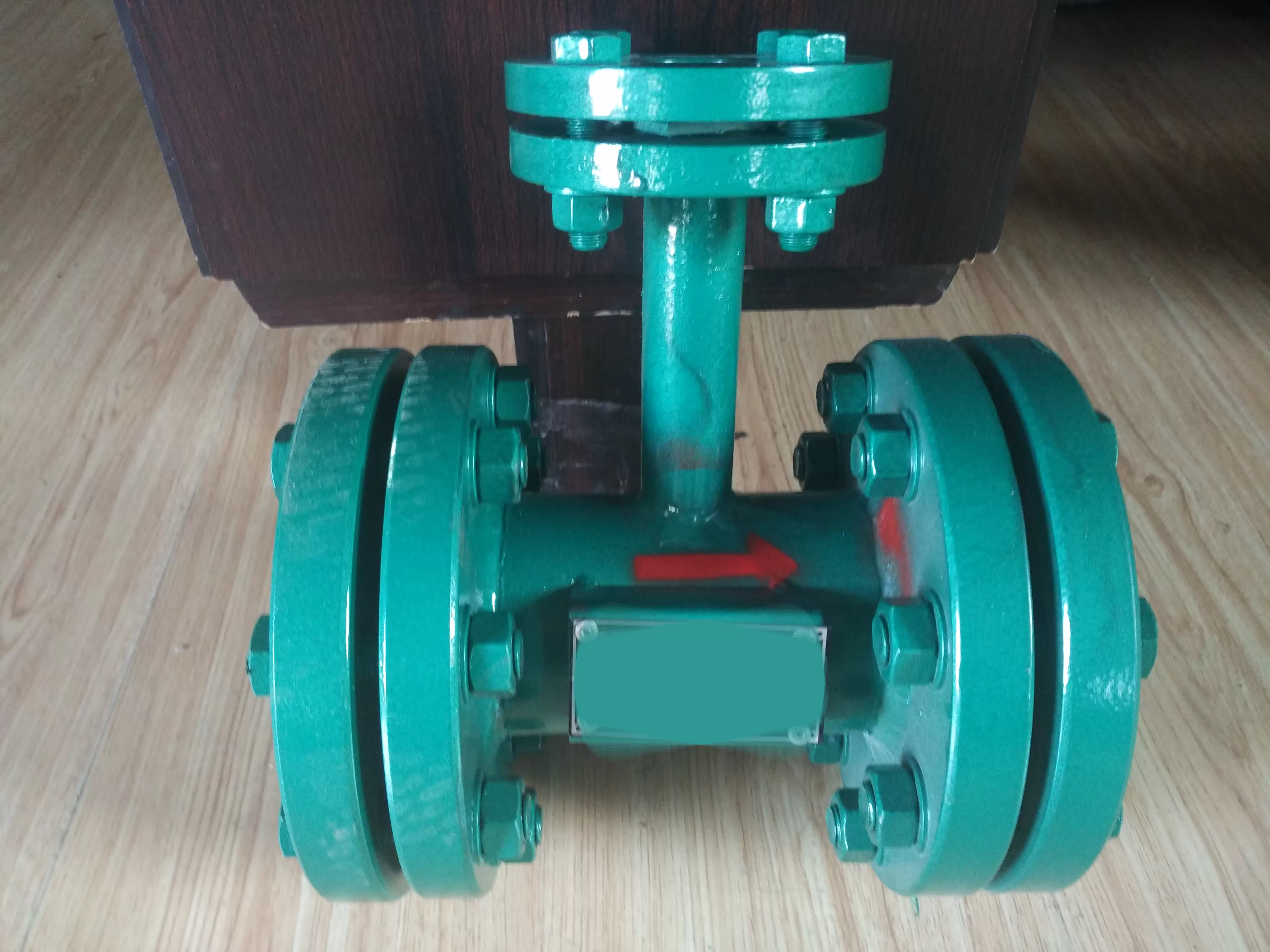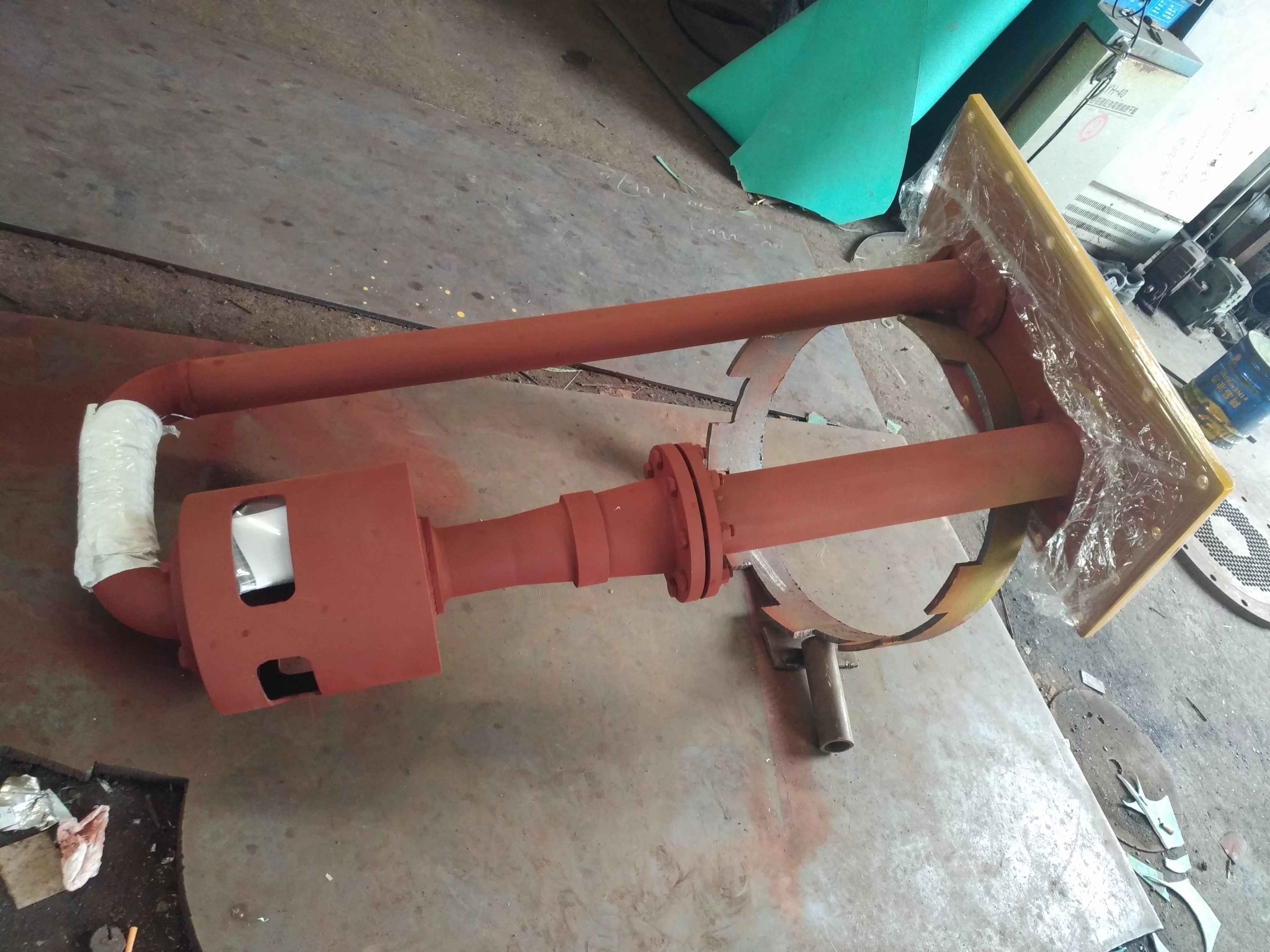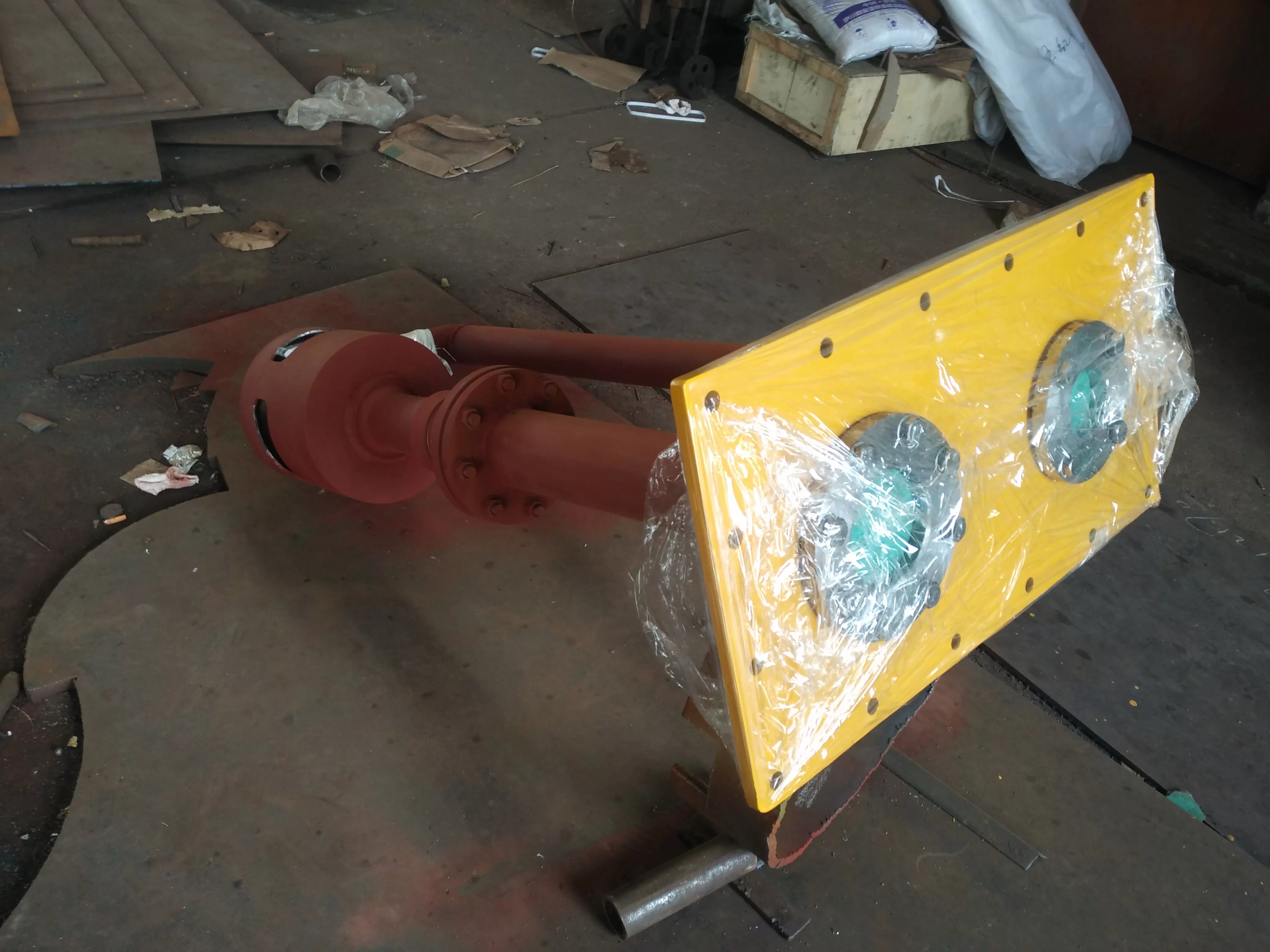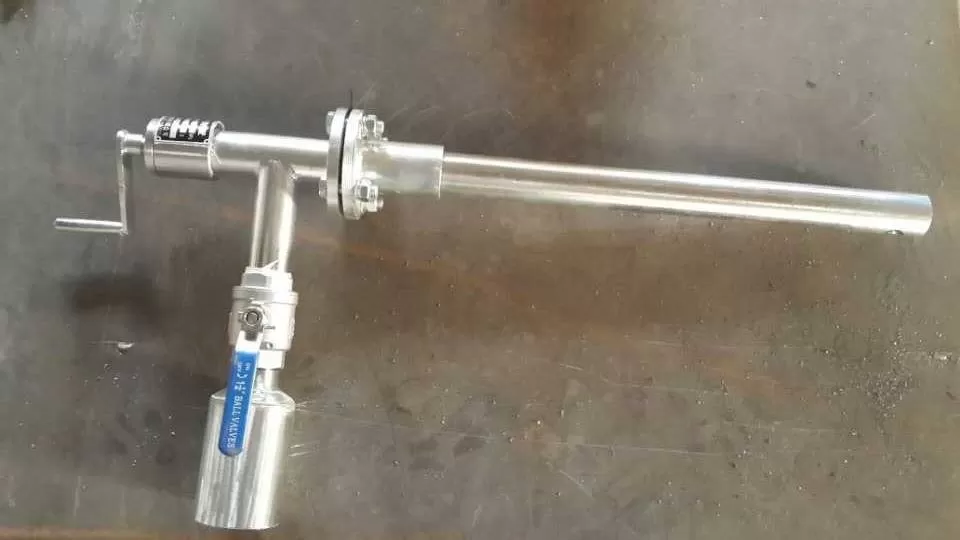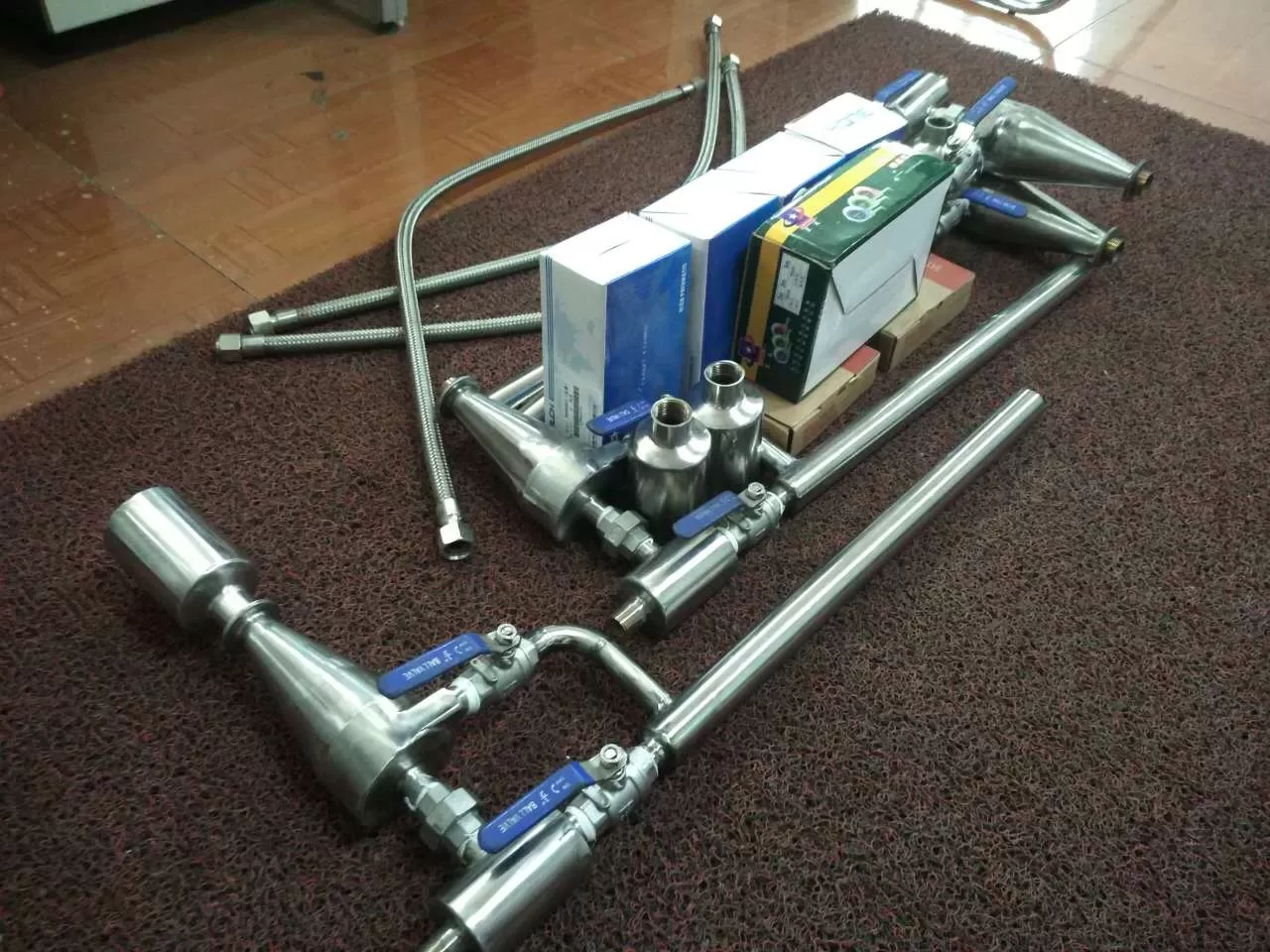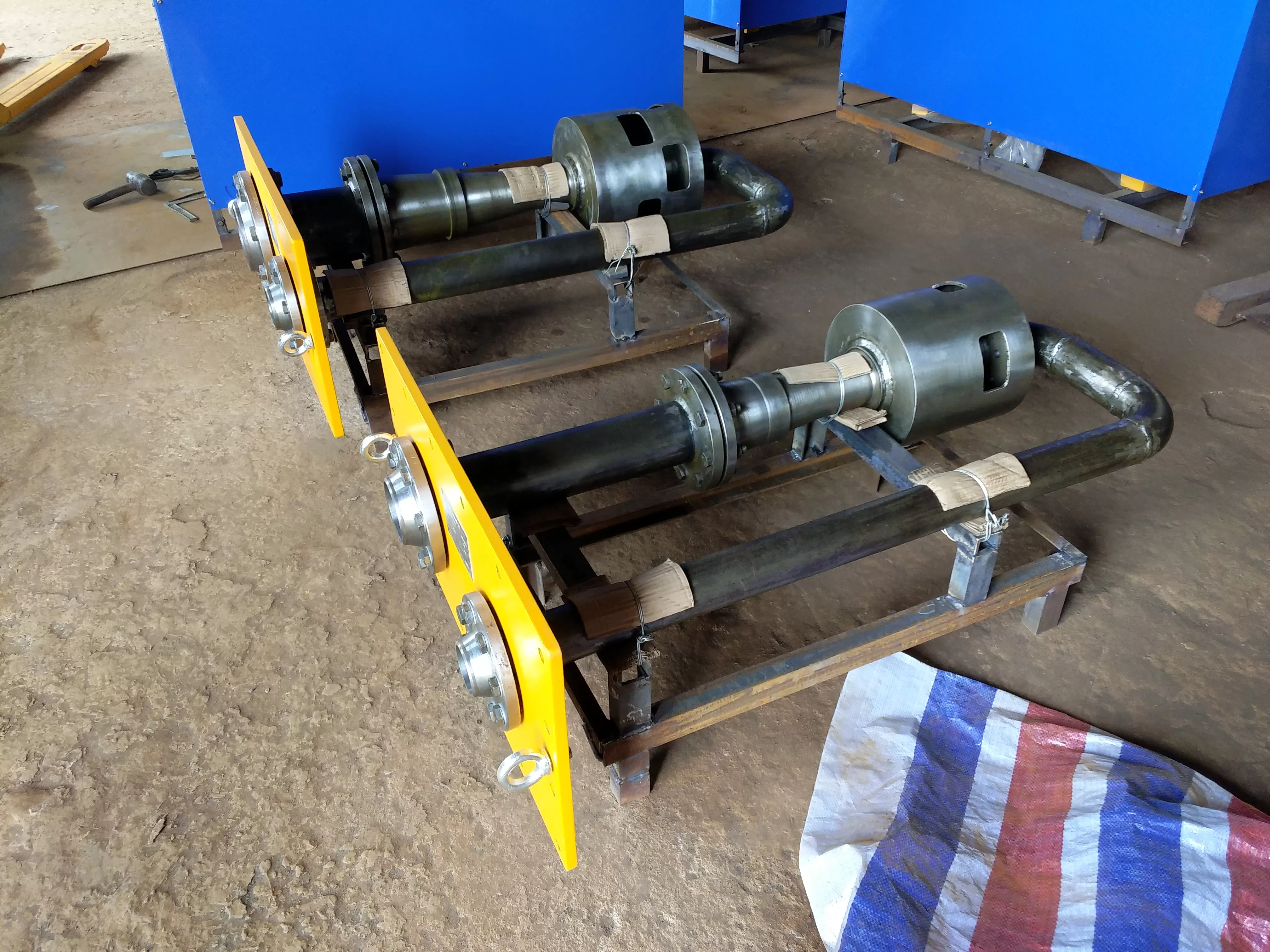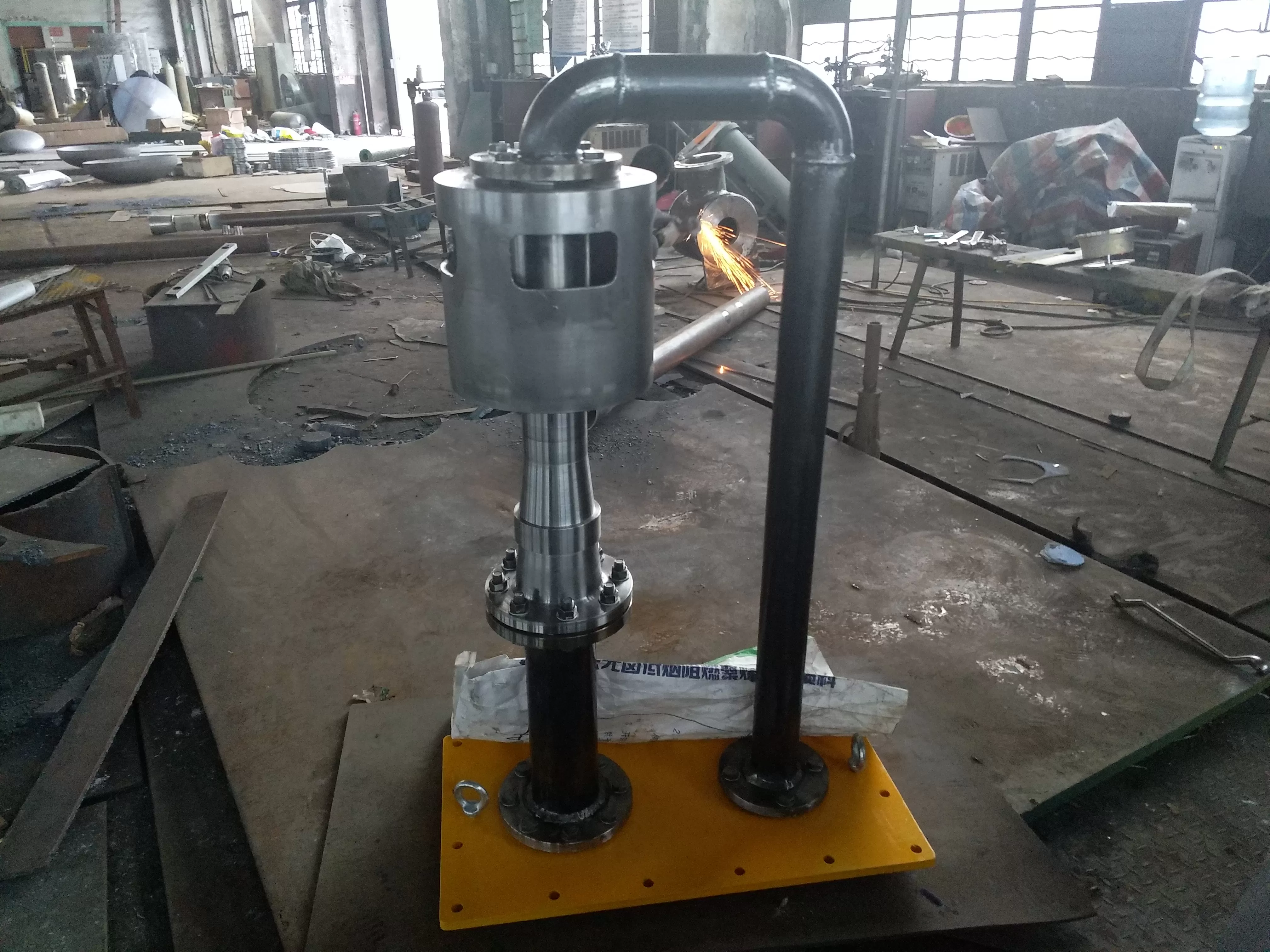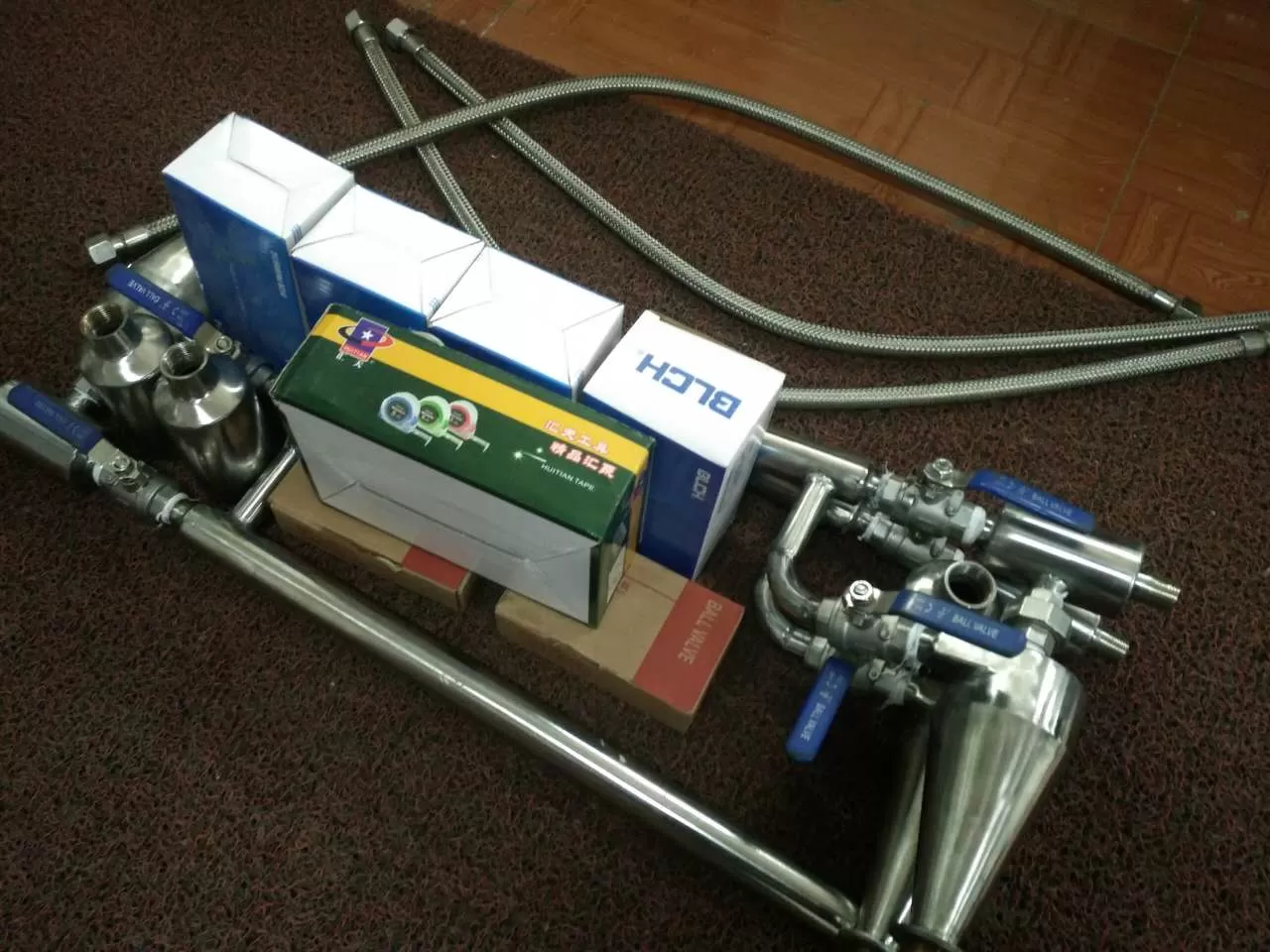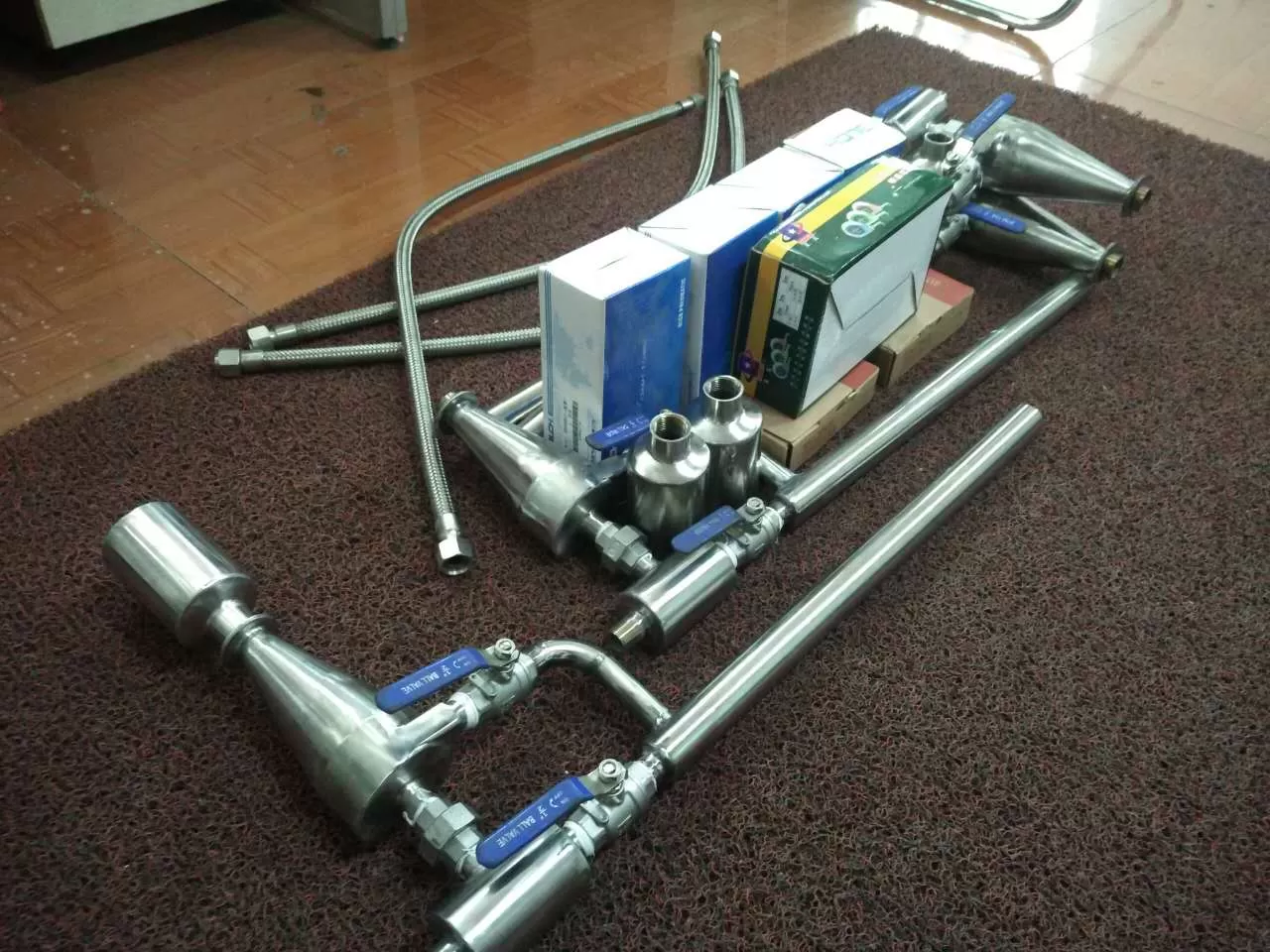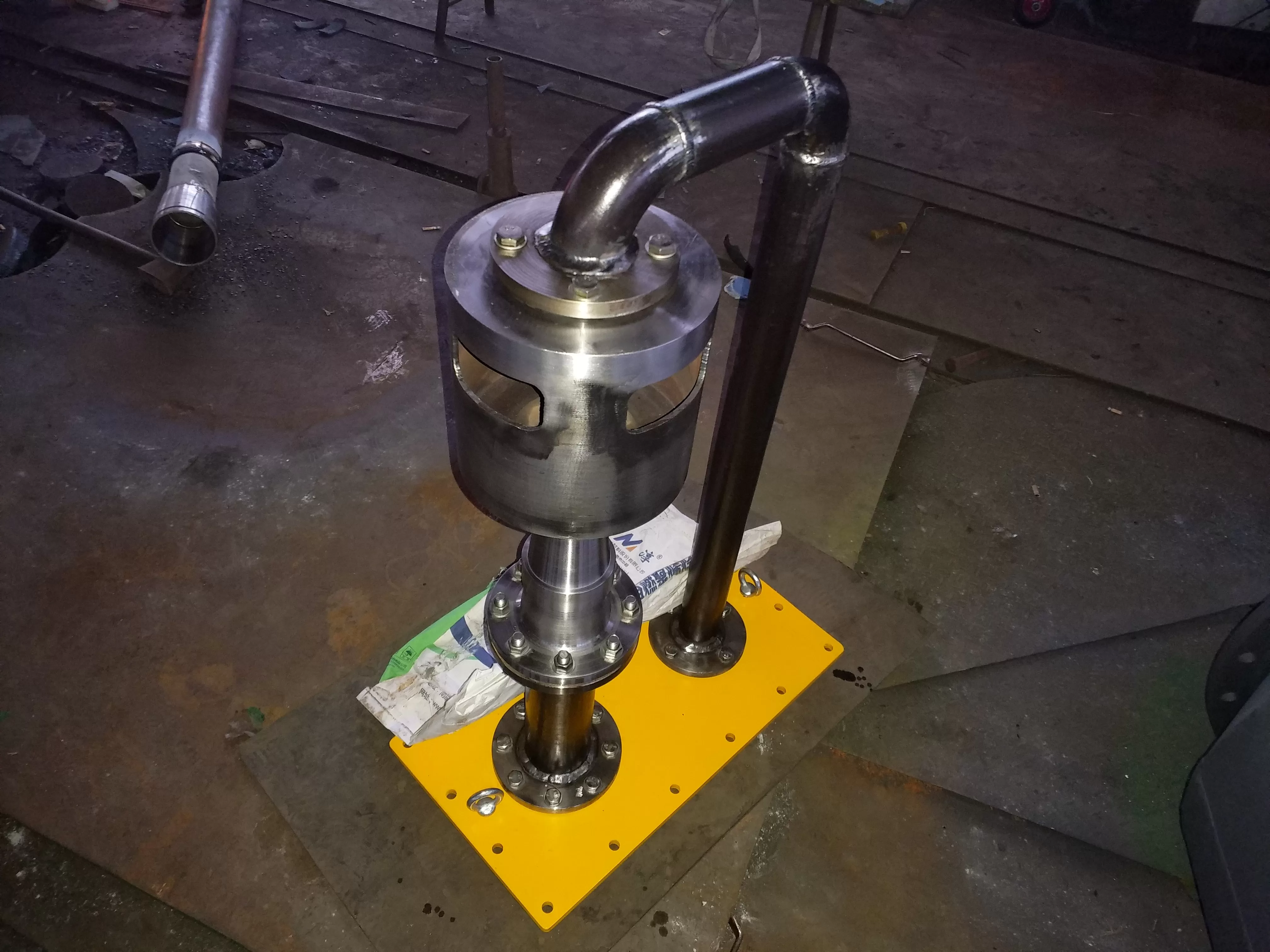Application of surface condenser:
The codenser is an essential component of the steam turbine system. Its function is to condense the exhaust steam of the steam turbine into water, forming and maintaining the required vacuum. Its work can directly affect the thermal economy and operational reliability of the entire system. So the condenser is one of the important auxiliary machines of the steam turbine unit, an important part of the electric thermal cycle, and has a decisive impact on the construction, safety, and economic operation of the entire thermal power plant.
The use of surface condensers can be summarized into four aspects:
1) Coagulation effect
The condenser takes away the latent heat of vaporization of the exhaust steam through the heat exchange between the cooling water and the exhaust steam, causing it to condense into water. The condensed water is recovered and heated to be reused as boiler feedwater.
2) Establish and maintain a constant vacuum
This is necessary to reduce the final coefficient of the unit and improve the circulation rate of the power plant.
3) Deoxygenation
Modern condensers, especially those in gas steam combined cycle units that do not have a single deaerator, and condensers in boiling water reactor nuclear power units, require deaeration to meet the anti-corrosion requirements of the unit.
4) Water storage effect
The water storage function of the condenser is to collect and store various hydrophobic, exhaust, and chemical makeup water from the condensate and thermal system. It is also necessary for buffering the rapid changes in unit flow, increasing system regulation stability, and ensuring the necessary suction pressure of the condensate pump.
Classification of condensers:
According to different steam condensation methods, condensers can be divided into two types: surface type (also known as wall type) and combined type (also known as contact type). In a surface condenser, steam separated from the cooling medium is condensed into a liquid on the cooling wall (through metal pipes). The cooling medium can be water or air. Water cooled surface condensers (condensers) are divided into two types based on the flow mode of cooling water: single process and double process. In a combined condenser, steam is condensed into a liquid when combined with the cooling medium. The condensed steam can be either water vapor or vapor from other substances. Nowadays, many power plants choose surface condensers
Retrofitting of existing and outdated condensers:
Due to various reasons, there are significant differences in the type and operating rate of condensers used in many power plants. In addition, some condensers have a long service life, and the outdated technology and design techniques have made the technical transformation and replacement of condensers very necessary. The technical renovation of power plants and outdated condensers refers to the detailed technical investigation and research conducted on the power plant site, proposing a specific renovation plan for the condensers, manufacturing the necessary components and technical data software for the renovation, completing installation, construction, and testing within the overhaul period of the power plant, and then delivering them for operation.
A. The purpose of condenser renovation
1) Improving the safety and reliability of the unit through renovation and replacement, using outdated condenser components and advanced technology, is a scientific, rational, and efficient way to improve the safety and reliability of the unit.
2) Improving the economy of the unit - under the condition of constant inlet steam temperature of the turbine, for every 10 ℃ decrease in exhaust temperature, the unit efficiency will increase by about 3.5%. For every 1KPa change in condensing pressure, the average power of the turbine will change by 1% to 2%. The cooling water pipes are arranged in a scientific, reasonable, and progressive manner, which significantly improves the efficiency. Internally, a vacuum deoxygenation device is installed to further adapt to the anti-corrosion requirements of the unit. According to the different operating water quality of each power plant (seawater, groundwater, surface water, etc.), different materials of titanium pipes, copper pipes, stainless steel pipes, etc. are used for cooling water. After considering thermal calculations, flow field calculations, and strength analysis, not only can the equipment meet the requirements and improve efficiency, but it is also easy to install and maintain.
B. Condenser renovation plan and construction:
1) After careful calculation analysis and comprehensive consideration, a reasonable layout of cooling water pipes is adopted inside the condenser. At the same time, different materials of cooling water pipes (titanium pipes, copper pipes, stainless steel pipes, etc.) are used according to the different cooling water quality of each plant (seawater, groundwater, surface water, etc.).
2) - Replace the condenser support plate, tube plate, etc.
3) Improve the housing and other components, etc. (Some shells can also be retained).
4) Install technical water replenishment devices and vacuum deoxygenation devices inside the condenser.
5) On site construction, installation, testing, and delivery for use. (or on-site guidance).
Surface condenser -:
1) Good thermal energy:
The condenser should have a high heat transfer coefficient to ensure good heat transfer results, so that the steam turbine has a lower operating back pressure under certain conditions and improves the heat rate of the steam power device. By using advanced flow field calculation software and strength analysis calculation software, analysis and calculation are carried out based on process parameters under different operating conditions, ensuring production and meeting design requirements under different operating conditions. Under the condition that the inlet temperature of the steam turbine remains constant. For every 10 ℃ decrease in exhaust temperature, the device efficiency increases by 3.5%; For every 1KPa change in condensing pressure, the average power of the turbine will change by 1% to 2%.
2) Capable of high sealing:
For different sealing structures, chemical design is carried out on the structures and materials to ensure that the equipment has good sealing energy, improve the air quality of the vacuum system, reduce air intake, and maintain the heat transfer energy of the condenser.
3) The condensing equipment requires good regenerative energy to reduce the supercooling of the condensate, in order to reduce the steam turbine's regenerative extraction and reduce heat consumption.
4) Good deoxygenation capacity:
According to the oxygen content requirements of the system's condensate, a heat and water removal device can be installed to provide good deoxygenation energy for the condenser and prevent corrosion of condensate pipelines and equipment.
5) Having smaller flow resistance and reducing power consumption of the circulating water pump:
Through thermal calculation, flow field calculation, and strength calculation analysis, while meeting the requirements of energy, chemical design is carried out on the structure to make the equipment more efficient. Through structural and system analysis, not only is the equipment required to meet the requirements, but it is also required to be as easy to manufacture, install, and maintain as possible.
Matching situation between surface condenser and unit:
1. The design of condensers is closely related to the unit:
Such as the back pressure parameters of the unit, the quality and parameters of the cooling water, the number of cooling water flow paths, the back pressure requirements of the condenser, and so on. The material and shape selection of cooling water pipes are also closely related to the design of condensers. Therefore, the design of surface type condensers requires detailed initial parameter data and matching requirements for the modified unit in the supporting design.
2. List some condenser design products:
1) The 25MW condensing steam turbine unit is equipped with an N-2000 model condenser, with a back pressure of 8KPa and a cooling water inlet temperature of 27 ℃. The cooling pipes are made of tin brass tubes, and the heat exchange area of the condenser is 2000 square meters.
2) The N-6815 model condenser of a 100MW unit is a dual shell, dual process condenser with a back pressure of 4.9KPa, cooling water temperature of 20 ℃, and a cooling area of 6815 square meters using tin brass pipes.
3) The N-7100 model condenser of the 125MW unit is a single shell, dual process condenser with a back pressure of 4.9KPa, cooling water temperature of 20 ℃, and a cooling area of 7100 square meters using tin brass pipes.
4) The N-12586 model condenser of a 200MW unit is a single shell, dual process condenser with a back pressure of 6.86KPa, a cooling water temperature of 20 ℃, and a tin brass cooling pipe with a cooling area of 12586 square meters.
5) The N-16000 model condenser of a 300MW unit is a single shell, dual process condenser with a back pressure of 5.4KPa, cooling water temperature of 20 ℃, and a cooling area of 16000 square meters using tin brass pipes.
6) The 300MW Qinshan Nuclear Power Plant has an all titanium condenser, with a heat exchange area of approximately 28000 square meters.
7) 600MW unit N-40000 model condenser, single shell, double shell, double pressure condenser, back pressure, low pressure shell 4KPa, high pressure shell 5.3KPa, cooling water - temperature 20 ℃, cooling tube made of tin brass tube, cooling area 40000 square meters.
The above types of units do not have complete matching condenser models, and specific surface type condensers need to be matched. It is necessary to inform the large units and what water quality is used? Water - chloride ion content - low? We will help you determine the final condenser model.
3. The selection of pipe bundle standards and the number of pipes for some condenser models:
机组容量 | 凝汽器型号 | 换热面积 | 管材规格(不锈钢管及铜管估计参数) | 数量 |
3MW | N-140 | 140m2 | Ф20x(0.6~1.0)x3500mm | 648根 |
3MW | N-280 | 280m2 | Ф20x(0.6~1.0)x3800mm | 1200根 |
6MW | N-560 | 560m2 | Ф20x(0.6~1.0)x3800mm | 2402根 |
12MW | N-1000 | 1000m2 | Ф20x(0.6~1.0)x4600mm | 3600根 |
25MW | N-2030 | 2030m2 | Ф20x(0.6~1.0)x7600mm | 4312根 |
N-2030 | 2030m2 | Ф24x(0.6~1.0)x6070mm | 4420根 |
N-2030 | 2030m2 | Ф25x(0.6~1.0)x6565mm | 3922根 |
50MW | N-3500 | 3500m2 | Ф25x(0.6~1.0)x8500mm | 5300根 |
100MW | N-6815 | 6815m2 | Ф25x(0.6~1.0)x8470mm | 10336根 |
125MW | N-7000 | 7000m2 | Ф25x(0.6~1.0)x7500 mm | 11900根 |
200MW | N-10300 | 10300m2 | Ф25x(0.6~1.0)x8500 mm | 15500根 |
200MW | N-12586 | 12586m2 | Ф25x(0.6~1.0)x9470 mm | 17132根 |
300MW | N-16000 | 16000m2 | Ф25x(0.6~1.0)x10500 mm | 19400根 |
600MW | N-30300 | 30300m2 | Ф25x(0.6~1.0)x14707 mm | 30300根 |
Composition of condenser structure:
A dual process condenser water-cooled surface condenser mainly consists of a shell, tube bundle, hot well, water chamber, and other parts. The exhaust of the steam turbine enters the casing through the throat, condenses into water on the cooling tube bundle, and collects in the hot well, which is then pumped out by the condensate pump. Cooling water (also known as circulating water) enters the cooling pipe bundle from the water chamber and is discharged from the outlet water chamber.
Design of condenser:
When designing a surface condenser, a technical and economic compar删除n should be made based on the steam turbine exhaust volume, exhaust area, annual or monthly average water temperature, and water supply method, including back pressure, cooling water ratio (referring to the ratio of cooling water volume to condensed steam volume, generally 50-120), and flow rate inside the cooling water pipe to determine the scheme. The condenser should have a reasonable arrangement of tube bundles on the structure to improve the overall heat transfer coefficient and reduce steam side resistance; Reasonably arrange the air cooling area and exhaust port to prevent the formation of air dead zones; Equipped with suction equipment to ensure good heat exchange; The throat should have good aerodynamics to ensure that the exhaust steam enters the cooling tube bundle more evenly, avoiding the formation of steam flow vortices and wasting some cooling area; The entire shell should have good air quality and sufficient stiffness to improve vacuum tightness and prevent deformation of the shell; To heat the condensate well and achieve a certain degree of deoxygenation effect through steam flow; Choose a reasonable span of the support plate based on the calculation of pipe vibration to avoid causing resonance of the pipe bundle during operation and causing damage to the pipe bundle.
Condenser protection:
The heat exchange tubes of condensers are mainly made of stainless steel tubes and copper tubes, while titanium tubes are used near the sea, with seawater as the medium. When carbon steel tube plates are used as condensers, corrosion leakage occurs at the welds between the tube plates and the tubes, and the leakage enters the cooling water system, causing environmental pollution and material waste. During production, manual arc welding is generally used for the welding between the tube plate and the column, and there are varying degrees of defects in the weld shape, such as dents, pores, slag inclusions, etc. The distribution of weld stress is also uneven. When in use, the part of the tube plate comes into contact with industrial cooling water, and impurities, salts, gases, and microorganisms in the industrial cooling water can corrode the tube plate and welds. Research has shown that industrial water, whether freshwater or seawater, contains various ions and dissolved oxygen, and the concentration changes of chloride ions and oxygen play a significant role in the corrosion shape of metals. In addition, the complexity of the metal structure can also affect the corrosion morphology. Therefore, the corrosion of the weld between the tube plate and the column is mainly pitting corrosion and crevice corrosion. From the outside, there will be some corrosion products and sediment on the surface of the tube plate, distributed with bubbles of varying sizes. When using seawater as a medium, galvanic corrosion can also occur, and bimetallic corrosion is a common phenomenon of tube plate corrosion.
Working principle of surface condenser:
A condenser is a typical steam turbine used in modern thermal and nuclear power plants. The condensing equipment is an important component of the steam turbine device, and its design, manufacturing, and operation directly affect the economy and safety of the steam turbine device. The condensing equipment plays a cold role in the thermal cycle of the steam turbine device. Reducing the exhaust temperature and pressure of the steam turbine can improve the thermal cycle cleaning rate. The main function of a condenser is to establish and maintain a high degree of vacuum at the turbine exhaust port, and to use the condensed water from the turbine exhaust as boiler feedwater to form a complete cycle. By exchanging heat with circulating water, the condenser maintains a high vacuum degree. Low vacuum will seriously affect the safe and economic operation of power plant units, and one of the main reasons for low vacuum is scaling in the cooling water pipes. The scaling of the steam turbine has a significant impact on the energy of the condenser. It not only increases the end difference of the steam turbine, but also reduces the vacuum degree of the steam turbine and increases the exhaust temperature, affecting the economy and safety of the steam turbine. For a long time, traditional cleaning methods such as mechanical methods (scraping, brushing), high-pressure water, and chemical cleaning (acid washing) have encountered many problems when cleaning equipment: they cannot remove deposits such as scale, acid can cause corrosion to the equipment, form holes, and residual acid can cause secondary corrosion or corrosion under the scale, ultimately leading to equipment replacement. In addition, there is cleaning waste liquid, which requires a large amount of funds for wastewater treatment. Condenser - equipped with a large number of copper pipes and circulated with cooling water. When the exhaust of the steam turbine comes into contact with the outer surface of the copper tube of the condenser, it is cooled by the water flow inside the copper tube, releasing latent heat of vaporization into condensate. The released latent heat is continuously transferred to the circulating cooling water through the copper tube wall and carried away. In this way, the exhaust steam is continuously condensed through the condenser. When the exhaust is cooled, its specific capacity rapidly decreases, resulting in a higher vacuum inside the condenser below the turbine exhaust port. A condenser is a large heat exchange equipment in thermal power plants.
Definition of vacuum degree for surface condenser:
The value read from the vacuum gauge is called vacuum degree. The vacuum degree value represents the value of the system pressure international value atmospheric pressure, that is, vacuum degree=atmospheric pressure opposition pressure. The main reason for the formation of vacuum in the condenser is that during the start-up process, vacuum is formed by the main and auxiliary pumps extracting a large amount of air from the turbine. In normal operation, the formation of vacuum is due to the rapid reduction of specific volume when the exhaust steam of the turbine suddenly condenses into water. If the volume of steam is 30000 times larger than that of water at a pressure of 4kpa, when the exhaust steam condenses into water, the volume is greatly reduced, causing a high degree of vacuum to form inside the condenser.
The formation and maintenance of condenser vacuum must meet three conditions:
1) Copper pipes must pass through a certain amount of cooling water;
2) The condensate pump must continuously pump out the condensate water to prevent the water level from rising and affecting the condensation of steam;
3) The extractor must extract the incoming air and other gases from the exhaust.
The reason for the decrease in condenser vacuum:
Reduction or interruption of circulating water volume: tripping of circulating water pump, incorrect closing of circulating valve, falling of butterfly valve core at the outlet of circulating water pump, blockage of circulating filter screen: water volume interruption, decrease of inlet pressure, vacuum of outlet water to -, and current of circulating pump to - or increase, must not damage vacuum shutdown; If it is not shut down, immediately reduce the load and restore it; Misclosure of the circulating valve, blockage of the water side plate pipe of the condenser, and absence of the ball collecting large mesh plate in the operating position: the circulating water pressure rises, and the temperature rise increases; Poor water inflow: The circulating pump current shakes, the inlet pressure decreases, the outlet vacuum decreases, the circulating water temperature increases, and the water volume is insufficient| 4 Q1 j - {3 u siphon failure (low inlet pressure, blocked plate tube, outlet side air): When the siphon effect is reduced, the water volume will decrease, but it will also increase the pressure of the circulating water main pipe. High pressure is beneficial for maintaining water volume, so siphon failure is a process. The outlet will shake and slowly decrease, and the temperature rise will increase.
Reasons and solutions for slow vacuum drop in surface condensers:
Due to the large size of the vacuum system, there are many factors that affect the vacuum. Therefore, when the vacuum slowly decreases, it is difficult to find the cause. You can check the following items and handle them.
1. Insufficient circulating water volume:
The insufficient circulating water is manifested in the increase of temperature difference between the inlet and outlet of the circulating water in the condenser under the same load, which may be due to blockage caused by entering debris. For units equipped with rubber ball cleaning devices, backwashing should be carried out. For units with siphons on the outlet pipe, it is necessary to check if the siphon is damaged. The phenomenon is that the vacuum on the outlet side increases while the inlet pressure increases. When the above situation occurs, the auxiliary air extractor of the circulating water system should be used to restore the vacuum at the outlet, and if necessary, the circulating water entering the condenser can be increased. The increase in temperature difference between the outlet of the condenser may also be due to the accumulation of air in the circulating water outlet pipe or severe scaling of the copper pipe. At this time, the air release valve of the outlet pipe should be opened to remove air or put into the rubber ball cleaning device for cleaning. If necessary, rinse with high-pressure water after shutdown.
2. The water level of the condenser rises:
The increase in water level may be caused by vaporization at the inlet of the condensate pump or rupture of the copper pipe leading to the circulation of water. The vaporization at the inlet of the condensate water pump can be judged by the decrease in the current of the condensate water pump. When it is confirmed that the water level is rising due to this reason, it is necessary to check whether the flange root on the inlet side of the water pump is not tight and whether air is entering. The rupture of copper pipes can be judged by testing the hardness of condensed water.
3. The working water temperature of the water jet pump increases:
The increase in working water temperature causes an increase in the pressure of the extraction chamber, which reduces the efficiency of the extractor. When the water temperature rises, industrial water replenishment should be turned on to reduce the working water temperature.
4. Vacuum system - human air:
The presence of air in the vacuum system can be checked through rigorous testing. In addition, when air enters the vacuum system, it also shows an increase in the subcooling of condensed water and an increase in the end difference.
The hazards of vacuum drop in condensers:
(1) Raise the exhaust pressure, reduce the available enthalpy drop, which is not economical, and at the same time, reduce the output of the unit;
(2) The increase in exhaust temperature may cause the copper tube to relax and cause severe damage;
(3) The increase in exhaust temperature causes thermal expansion of the exhaust cylinder and bearing seat, resulting in changes in the center of gravity and vibration;
(4) The axial displacement of the steam turbine increases, causing overload and wear of the force bearing;
(5) The decrease in vacuum causes a decrease in the volumetric flow rate of the exhaust, which generates a significant vibration force on a certain part of the final blade, potentially damaging the blade and causing accidents
The main reasons for the tightness and poor performance of surface condensers and their steam side:
1. At the flange or weld connection between the exhaust cylinder of the steam turbine and the throat of the condenser - gas. If the sleeve water seal connection method is used, the deformation of the throat causes the packing to move, the packing is not pressed tightly, or the sealing water is insufficient.
2. There is a problem or improper operation of the end shaft seal of the steam turbine.
3. The joint surface and gauge joints of the low-pressure cylinder of the steam turbine are not tight.
4. Regarding loose valves or insufficient water flow in water sealed valves.
5. The axial sealing of the condensate pump is not tight.
6. The steam side space of the low-pressure feedwater heater is not tight.
7. Equipment or pipeline damage or welding seam problems.
Water side of condenser:
1. Leakage at the end of the expansion tube. When using the padding method to connect pipes and tube plates, the filling part is not sealed.
2. Erosion occurs at the end of the pipe.
3. The cooling pipe is damaged. Condenser end difference: the difference between the saturation temperature under pressure and the outlet temperature of the cooling water. The size of the end difference for a fixed condenser is related to the inlet temperature of the cooling water, the steam load per unit area, the surface cleanliness of the copper tube, the amount of air entering the tube, and the flow rate of the cooling water inside the tube- A clean condenser has a fixed end difference index at a fixed circulating water temperature, circulating water volume, and unit steam load. Generally, the end difference index is that as the circulating water volume increases, the lower the outlet temperature of the cooling water, the greater the end difference, and vice versa; The larger the unit steam load, the greater the end difference, and vice versa- If the end difference is too high compared to the end difference index value, it indicates that the copper pipes on the cooling surface are dirty, leading to improved thermal conductivity conditions.
The reason for the increase in condenser end difference:
1. Fouling on the water or steam side of copper pipes;
2. Steam side - incoming air;
3. Cooling water pipe blockage;
4. When the cooling water volume decreases and the subcooling liquid temperature of the condenser reaches the theoretical crystallization temperature, crystallization cannot occur. Instead, crystallization must begin at a temperature below its theoretical temperature (known as the initial crystallization temperature). In the process of intercrystalline crystallization, the intercrystalline temperature is always lower than the theoretical crystallization temperature, and this phenomenon is called undercooling. The temperature difference between the two is called undercooling.
The causes of subcooling in the condenser:
Due to the difference between the steam partial pressure on the outer surface of the cooling water pipe and the average steam partial pressure between the pipe bundles, the condensation temperature of the steam - the temperature of the combined steam flow between the pipe bundles - results in subcooling. Due to the presence of steam resistance inside the condenser, steam encounters resistance when flowing downwards from the exhaust port, resulting in lower steam pressure - upper pressure. The temperature of the condensate in the lower part is lower than that in the upper part, leading to subcooling. When steam is cooled into droplets, it flows between the cooling water pipes and is cooled by circulating water inside the pipes. As the temperature of the droplets is higher than that of the wall of the cooling water pipe, the condensed water cools down and reaches its saturation temperature, resulting in supercooling. Due to the accumulation of air on the steam side, the air partial pressure increases, and the steam partial pressure relatively decreases. The steam still condenses at its own partial pressure, causing the temperature of the condensate to be lower than the exhaust temperature, resulting in subcooling- There are defects in the structure, and the arrangement of the cooling water pipe bundle is unreasonable, causing the condensed water to form a layer of water film outside the cooling water pipe. When the water film thickens and sags into water droplets, the temperature of the water droplets is the average temperature inside and outside the water film minus the saturation temperature on the outer surface of the water film, resulting in supercooling- If the air inlet or the air extractor is not working properly, the air cannot be extracted in time, and the air partial pressure increases, resulting in an increase in subcooling. The water level in the hot water well is higher than the normal range, and some copper pipes in the condenser are submerged, causing the submerged copper pipes - circulating water - to take away some of the heat from the condensate and generate supercooling. The low temperature of the circulating water and the excessive amount of circulating water result in excessive cooling of the condensate, leading to an increase in subcooling. The copper tube of the condenser ruptures, causing circulating water to enter the condensate, resulting in a decrease in condensate temperature and an increase in subcooling. The degree of subcooling of condensate is an important indicator to measure the economic operation of a condenser. A low degree of subcooling indicates that the heat carried away by the circulating water is less and the unit is more economical. Conversely, a high degree of subcooling indicates that the heat carried away by the circulating water is less and the unit is less economical. According to the data, for every 1 increase in subcooling, the heat consumption rate of the unit increases by 0.02%
Technical parameters of surface condenser:
| 汽轮机凝汽器型号 | n-140 | n-280 | n-280-1 | n-280-2 | n-420 | n-560 | n-1000 | n-1250 | n-2000 | n-4200 |
| 凝汽器冷却面积 | 140 | 280 | 280 | 280 | 420 | 560 | 1000 | 1250 | 2000 | 4200 |
| 汽轮机凝汽器型式 | 单道双流程 | 双道双流程 |
| 外型尺寸 | L | 4168 | 4984 | 5476 | 4984 | 4968 | 5082 | 6176 | 7280 | 8300 | 9600 |
| H | 2822 | 3043 | 3030 | 3043 | 3482 | 3757 | 4315 | 4315 | 4500 | 7043 |
| W | 1582 | 1936 | 1690 | 1936 | 2400 | 2795 | 3100 | 3174 | 4150 | 4680 |
| 进汽口尺寸 | D | 800 | 1090 | 940 | 1090 | 1220 | 1100 | 2000x1350 | 2000x1350 | 4000x1250 | 5300x2250 |
| 进出水口尺寸 | D | 250 | 300 | 300 | 300 | 400 | 400 | 600 | 700 | 700 | 1000 |
| 冷却水量 | t/h | 504 | 874 | 874 | 874 | 1100 | 1900 | 3420 | 4000 | 4900 | 11500 |
| -水净- | kg | 3130 | 6080 | 6700 | 6160 | 10000 | 14500 | 23000 | 29000 | 37300 | 79428 |
以下凝汽器换管凝汽器换不锈钢管技术参数(汽轮机凝汽器)304/316L不锈钢换热管规格技术参数仅供参考,详细参数电话咨询我们!以实际管束为准,可按客户要求设计相应管束!
| 不锈钢管换热管材料 | O | SI | MN | P | S | NI | CR | MO | n-2000 | n-4200 |
| 304不锈钢管换热管≤ | ≤0.080 | 0.75 | 2.00 | 0.040 | 0.030 | 8.00-11.00 | 18.00-20.00 | - | 2000 | 4200 |
| 304L不锈钢管换热管≤ | 0.035 | 0.75 | 2.00 | 0.040 | 0.030 | 8.00-13.00 | 18.00-20.00 | - |
|
|
| 316不锈钢管换热管 ≤ | 0.080 | 0.75 | 2.00 | 0.040 | 0.030 | 10.00-14.00 | 16.00-18.00 | 2.00-3.00 | 8300 | 9600 |
| 316L不锈钢管换热管≤ | 0.035 | 0.75 | 2.00 | 0.040 | 0.030 | 10.00-15.00 | 16.00-18.00 | 2.00-3.00 | 4500 | 7043 |
| N | O | H | FC | O | AI | V | 3174 | 4150 | 4680 |
| 不锈钢换热管∠ | ∠0.02 | 0.05 | 0.015 | 0.25 | 0.12 | 2.5-3.5 | 2.0-3.0 |
|
|
|
| 不锈钢换热管型号 |
|
| 1 | Φ14×0.5 | Φ14×0.6 | Φ14×0.7 | Φ14×0.8 |
|
|
|
| 2 | Φ15×0.5 | Φ15×0.6 | Φ15×0.7 | Φ15×0.8 |
|
|
|
| 3 | Φ16×0.5 | Φ16×0.6 | Φ16×0.7 | Φ16×0.8 |
|
|
|
| 4 | Φ18×0.5 | Φ18×0.6 | Φ18×0.7 | Φ18×0.8 |
|
|
|
| 5 | Φ19×0.5 | Φ19×0.6 | Φ19×0.7 | Φ19×0.8 |
|
|
|
| 6 | Φ20×0.5 | Φ20×0.6 | Φ20×0.7 | Φ20×0.8 | Φ20×1.0 |
|
|
| 7 | Φ22×0.5 | Φ22×0.6 | Φ22×0.7 | Φ22×0.8 | Φ22×1.0 | Φ22×1.2 |
|
| 8 | Φ25×0.5 | Φ25×0.6 | Φ25×0.7 | Φ25×0.8 | Φ25×1.0 | Φ25×1.2 | Φ25×1.5 |
| 9 | Φ26×0.5 | Φ26×0.6 | Φ26×0.7 | Φ26×0.8 | Φ28×1.0 | Φ28×1.2 | Φ28×1.5 |
| 10 |
| Φ30×0.6 | Φ30×0.7 | Φ30×0.8 | Φ30×1.0 | Φ30×1.2 | Φ30×1.5 |
| 11 |
|
| Φ32×0.7 | Φ32×0.8 | Φ32×1.0 | Φ32×1.2 | Φ32×1.5 |
不锈钢管各种型号化学成分对照表:
| 管材型号规格 | 碳 | 锰 | 磷
(P) | 硫
(S) | 硅
( Si ) | 镍
( Ni ) | 铬
(CR ) | 钼
(Mo) |
| C | Mn |
| 304 | ≤0.08 | ≤2.00 | ≤0.035 | ≤0.03 | ≤0.1 | ≤8.00-10.50 | ≤18.00-20.00 |
|
| 304L | ≤0.03 | ≤2.00 | ≤0.035 | ≤0.03 | ≤0.1 | ≤9.00-13.00 | ≤18.00-20.00 |
|
| 316 | ≤0.08 | ≤2.00 | ≤0.035 | ≤0.03 | ≤0.1 | ≤10.00-14.00 | ≤16.00-18.00 | 2.00-3.00 |
| 316L | ≤0.03 | ≤2.00 | ≤0.035 | ≤0.03 | ≤0.1 | ≤10.00-14.00 | ≤16.00-18.00 | 2.00-3.00 |
|
|
|
|
|
|
|
|
|
铜管与不锈钢管换热遥遥能对照表:
| 名称 |
|
| 规格 | 材质 | 总体换热系数(W/m².k) | 不锈钢管与铜管比
总体换热系数提高% |
|
|
|
|
| 铜管 |
|
| 1.0(mm) | HSn70-1A | 3682.413869 | 0 |
|
|
| 不锈钢管 |
|
| 1.0(mm) | 304,304l,316,316L | 3460.327347 | -6 |
|
|
| 不锈钢管 |
|
| 0.7(mm) | 304,304l,316,316L | 3760.628476 | 2.214 |
|
|
| 不锈钢管 |
|
| 0.6(mm) | 304,304l,316,316L | 3872.606729 | 5.214 |
|
|
| 不锈钢管 |
|
| 0.5(mm) | 304,304l,316,316L | 3992.015968 | 8.408 |
|
|
|
|
|
|
|
|
|
|
|
介质水-适应氯离子含量指标对照表:
| 管材 |
|
| H68-A | HSn70-1 | TP304,TP304L | TP316,TP316L | TP317,TP317L |
|
|
|
长期遥遥
氯离子含量
(mg/L) |
|
| ≤50 | ≤100 | ≤150 | ≤300 | ≤500 |
|
短期遥遥
氯离子含量
(mg/L) |
|
| ≤100 | ≤200 | ≤300 | ≤500 | ≤1000 |
|
|
|
|
|
|
|
|
|
|
